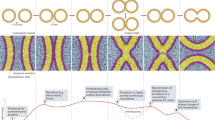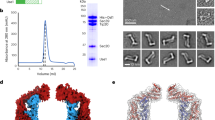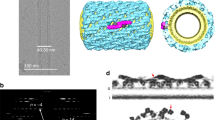Abstract
In eukaryotes, most intracellular membrane fusion reactions are mediated by the interaction of SNARE proteins that are present in both fusing membranes. However, the minimal number of SNARE complexes needed for membrane fusion is not known. Here we show unambiguously that one SNARE complex is sufficient for membrane fusion. We performed controlled in vitro Förster resonance energy transfer (FRET) experiments and found that liposomes bearing only a single SNARE molecule are still capable of fusion with other liposomes or with purified synaptic vesicles. Furthermore, we demonstrated that multiple SNARE complexes do not act cooperatively, showing that synergy between several SNARE complexes is not needed for membrane fusion. Our findings shed new light on the mechanism of SNARE-mediated membrane fusion and call for a revision of current views of fusion events such as the fast release of neurotransmitters.
This is a preview of subscription content, access via your institution
Access options
Subscribe to this journal
Receive 12 print issues and online access
$189.00 per year
only $15.75 per issue
Buy this article
- Purchase on Springer Link
- Instant access to full article PDF
Prices may be subject to local taxes which are calculated during checkout






Similar content being viewed by others
References
Brunger, A.T., Weninger, K., Bowen, M. & Chu, S. Single-molecule studies of the neuronal SNARE fusion machinery. Annu. Rev. Biochem. 78, 903–928 (2009).
Jahn, R. & Scheller, R.H. SNAREs-engines for membrane fusion. Nat. Rev. Mol. Cell Biol. 7, 631–643 (2006).
Weber, T. et al. SNAREpins: minimal machinery for membrane fusion. Cell 92, 759–772 (1998).
Liu, W. et al. Single molecule mechanical probing of the SNARE protein interactions. Biophys. J. 91, 744–758 (2006).
Bowen, M.E., Weninger, K., Brunger, A.T. & Chu, S. Single molecule observation of liposome-bilayer fusion thermally induced by SNAREs. Biophys. J. 87, 3569–3584 (2004).
Hua, Y. & Scheller, R.H. Three SNARE complexes cooperate to mediate membrane fusion. Proc. Natl. Acad. Sci. USA 98, 8065–8070 (2001).
Keller, J.E., Cai, F. & Neale, E.A. Uptake of botulinum neurotoxin into cultured neurons. Biochemistry 43, 526–532 (2004).
Han, X., Wang, C.T., Bai, J., Chapman, E.R. & Jackson, M.B. Transmembrane segments of syntaxin line the fusion pore of Ca2+-triggered exocytosis. Science 304, 289–292 (2004).
Montecucco, C., Schiavo, G. & Pantano, S. SNARE complexes and neuroexocytosis: how many, how close? Trends Biochem. Sci. 30, 367–372 (2005).
Pobbati, A.V., Stein, A. & Fasshauer, D. N- to C-terminal SNARE complex assembly promotes rapid membrane fusion. Science 313, 673–676 (2006).
Cypionka, A. et al. Discrimination between docking and fusion of liposomes reconstituted with neuronal SNARE-proteins using FCS. Proc. Natl. Acad. Sci. USA 106, 18575–18580 (2009).
Margittai, M., Fasshauer, D., Pabst, S., Jahn, R. & Langen, R. Homo- and heterooligomeric SNARE complexes studied by site-directed spin labeling. J. Biol. Chem. 276, 13169–13177 (2001).
Fasshauer, D. & Margittai, M. A transient N-terminal interaction of SNAP-25 and syntaxin nucleates SNARE assembly. J. Biol. Chem. 279, 7613–7621 (2004).
Parlati, F. et al. Rapid and efficient fusion of phospholipid vesicles by the alpha-helical core of a SNARE complex in the absence of an N-terminal regulatory domain. Proc. Natl. Acad. Sci. USA 96, 12565–12570 (1999).
Siddiqui, T.J. et al. Determinants of synaptobrevin regulation in membranes. Mol. Biol. Cell 18, 2037–2046 (2007).
Boukobza, E., Sonnenfeld, A. & Haran, G. Immobilization in surface-tethered lipid vesicles as a new tool for single biomolecule spectroscopy. J. Phys. Chem. B 105, 12165–12170 (2001).
Das, S.K., Darshi, M., Cheley, S., Wallace, M.I. & Bayley, H. Membrane protein stoichiometry determined from the step-wise photobleaching of dye-labeled subunits. ChemBioChem 8, 994–999 (2007).
van den Bogaart, G. et al. Dual-color fluorescence-burst analysis to study pore formation and protein-protein interactions. Methods 46, 123–130 (2008).
Kucerka, N., Tristram-Nagle, S. & Nagle, J.F. Structure of fully hydrated fluid phase lipid bilayers with monounsaturated chains. J. Membr. Biol. 208, 193–202 (2005).
Woodbury, D.J. & Rognlien, K. The t-SNARE syntaxin is sufficient for spontaneous fusion of synaptic vesicles to planar membranes. Cell Biol. Int. 24, 809–818 (2000).
Holt, M., Riedel, D., Stein, A., Schuette, C. & Jahn, R. Synaptic vesicles are constitutively active fusion machines that function independently of Ca2+. Curr. Biol. 18, 715–722 (2008).
Kendall, D.A. & MacDonald, R.C. Characterization of a fluorescence assay to monitor changes in the aqueous volume of lipid vesicles. Anal. Biochem. 134, 331926–331983 (1983).
van den Bogaart, G., Guzmán, J.V., Mika, J.T. & Poolman, B. On the mechanism of pore formation by melittin. J. Biol. Chem. 283, 33854–33857 (2008).
Wiederhold, K. & Fasshauer, D. Is assembly of the SNARE complex enough to fuel membrane fusion? J. Biol. Chem. 284, 13143–13152 (2009).
Li, F. et al. Energetics and dynamics of SNAREpin folding across lipid bilayers. Nat. Struct. Mol. Biol. 14, 890–896 (2007).
Liu, W., Montana, V., Parpura, V. & Mohideen, U. Comparative energy measurements in single molecule interactions. Biophys. J. 95, 419–425 (2008).
Yersin, A. et al. Interactions between synaptic vesicle fusion proteins explored by atomic force microscopy. Proc. Natl. Acad. Sci. USA 100, 8736–8741 (2003).
Kozlovsky, Y. & Kozlov, M.M. Stalk model of membrane fusion: solution of energy crisis. Biophys. J. 82, 882–895 (2002).
Siegel, D.P. & Kozlov, M.M. The Gaussian curvature elastic modulus of N-monomethylated dioleoylphosphatidylethanolamine: relevance to membrane fusion and lipid phase behavior. Biophys. J. 87, 366–374 (2004).
Hui, E., Johnson, C.P., Yao, J., Dunning, F.M. & Chapman, E.R. Synaptotagmin-mediated bending of the target membrane is a critical step in Ca2+-regulated fusion. Cell 138, 709–721 (2009).
Bethani, I. et al. Endosomal fusion upon SNARE knockdown is maintained by residual SNARE activity and enhanced docking. Traffic 10, 1543–1559 (2009).
Wickner, W. Yeast vacuoles and membrane fusion pathways. EMBO J. 21, 1241–1247 (2002).
Takamori, S. et al. Molecular anatomy of a trafficking organelle. Cell 127, 831–846 (2006).
Sieber, J.J. et al. Anatomy and dynamics of a supramolecular membrane protein cluster. Science 317, 1072–1076 (2007).
Wienisch, M. & Klingauf, J. Vesicular proteins exocytosed and subsequently retrieved by compensatory endocytosis are nonidentical. Nat. Neurosci. 9, 1019–1027 (2006).
Littleton, J.T. et al. Temperature-sensitive paralytic mutations demonstrate that synaptic exocytosis requires SNARE complex assembly and disassembly. Neuron 21, 401–413 (1998).
Schuette, C.G. et al. Determinants of liposome fusion mediated by synaptic SNARE proteins. Proc. Natl. Acad. Sci. USA 101, 2858–2863 (2004).
Chung, S.H. & Kennedy, R.A. Forward-backward non-linear filtering technique for extracting small biological signals from noise. J. Neurosci. Methods 40, 71–86 (1991).
Acknowledgements
We thank M. Druminski, A. Stein and U. Ries for technical support and L.K. Tamm and coworkers for critical comments. This work was supported by grants from the US National Institutes of Health (P01 GM072694) and the Deutsche Forschungsgemeinschaft (SFB803). G.v.d.B. is financed by the Human Frontier Science Program. G.B. is financed by the Deutsche Forschungsgemeinschaft (EXC171).
Author information
Authors and Affiliations
Contributions
G.v.d.B. purified the proteins, designed, performed and analyzed the FRET and sequential photobleaching experiments, and programmed the software for the data analysis. M.G.H. purified the synaptic vesicles and performed the partial proteolysis and flotation experiments. G.B. and F.S.W. assisted with the microscopy. D.R. performed the electron microscopy. G.v.d.B. and R.J. designed the study and wrote the paper. All authors discussed the results and commented on the manuscript.
Corresponding author
Ethics declarations
Competing interests
The authors declare no competing financial interests.
Rights and permissions
About this article
Cite this article
van den Bogaart, G., Holt, M., Bunt, G. et al. One SNARE complex is sufficient for membrane fusion. Nat Struct Mol Biol 17, 358–364 (2010). https://doi.org/10.1038/nsmb.1748
Received:
Accepted:
Published:
Issue Date:
DOI: https://doi.org/10.1038/nsmb.1748
This article is cited by
-
Mechanisms of SNARE proteins in membrane fusion
Nature Reviews Molecular Cell Biology (2024)
-
Vesicle trafficking and vesicle fusion: mechanisms, biological functions, and their implications for potential disease therapy
Molecular Biomedicine (2022)
-
Regulation of the mammalian-brain V-ATPase through ultraslow mode-switching
Nature (2022)
-
Graph-theoretic constraints on vesicle traffic networks
Journal of Biosciences (2022)
-
ORP/Osh mediate cross-talk between ER-plasma membrane contact site components and plasma membrane SNAREs
Cellular and Molecular Life Sciences (2021)



